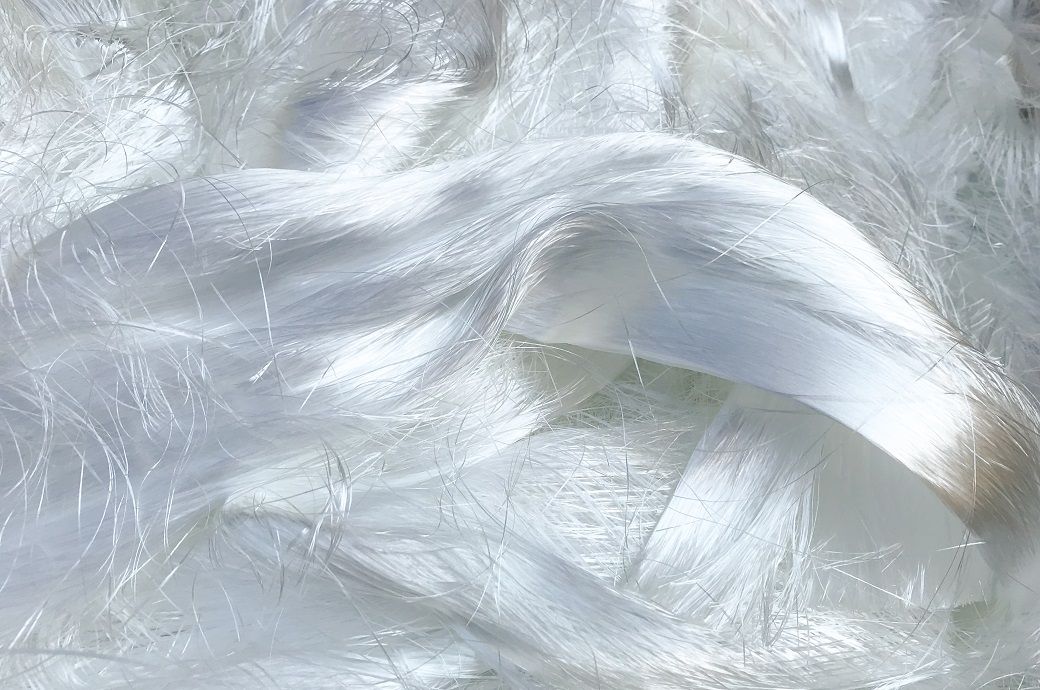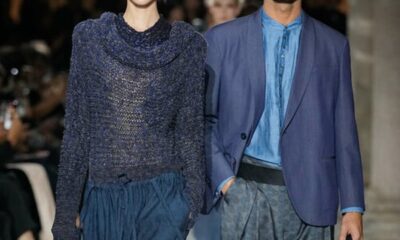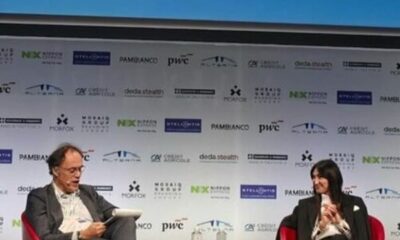Fashion
Serapian unveils bold S/S 2026 collection and expands in Japan

Translated by
Nazia BIBI KEENOO
Published
September 29, 2025
Set against the refined backdrop of its Milanese headquarters, Villa Mozart, Serapian unveiled its Spring/Summer 2026 collection, “Sunrise of Mestieri d’Arte,” during Milan Fashion Week. The presentation marked the second chapter of its ongoing collaboration with British designer Bethan Laura Wood — a partnership that first debuted last April at Salone del Mobile.
With this new collection, Wood weaves her signature color harmonies with Serapian’s artisanal savoir-faire, emphasizing materiality, innovation, and emotive storytelling. She reimagines the Secret, Mini Secret, and Anì bags in a palette dominated by azure, pink, off-white, and ice — blended into a chiaroscuro inspired by the Japanese Bokashi printing technique. Each piece highlights the versatility of the maison’s Mosaico technique. The collection also includes a pink-and-white shoulder strap designed to elevate Serapian bags, as well as a unisex travel bag in olive green and brown.
“We are in a phase of expansion, driven by the fact that today’s clients increasingly seek exceptional craftsmanship, design, and the quality of the handmade. They want to return to the roots of luxury and craftsmanship — to what is authentic and rare,” said Maxime Bohé, CEO of Serapian, in a statement to FashionNetwork.com. “This is why, for example, we are performing particularly well in Japan, a highly discerning market when it comes to craftsmanship, with a strong culture of research. Last June, we opened our first Japanese flagship, Villa Serapian, in Tokyo. We are also present in four department stores in the capital, as well as in Osaka and Sapporo.”

“What’s really important for us is finding locations that double as experiential spaces — like Villa Mozart — where we can offer our bespoke services. These have been particularly successful with Italian, American, Japanese, and Middle Eastern clients,” the CEO added. “These are people who already have everything and are looking for truly rare and unique pieces. E-commerce is also growing steadily, particularly around Mosaico, which represents the maison’s identity. We also have new mono-brand openings in the pipeline, but we cannot reveal the details yet.”
Returning to the Spring/Summer 2026 collection, one of the new arrivals is the Maro bag, distinguished by a strip of knotted nappa on each side. It will be available in four styles: maxi tote, medium tote, mini handbag, and crossbody.
Color and light take center stage this season, with new shades such as indigo, aqua, blush, sand, and antique rose complementing the brand’s classics. New Mosaico developments include Ribbon, featuring a three-dimensional texture created by interlacing cotton ribbons, and the Microchain series, which adds luminosity to the maison’s creations with delicate metal chains.

The classic Secret bag has been reinterpreted using new artisanal techniques, including Mosaico Crochet, featuring a raffia motif, and Raffia Denim, which blends both materials. The Chiaroscuro Canvas series also includes, for the first time, a matching beach towel.
For men, the Stepan collection is now available in a new iteration, featuring asphalt cotton canvas with Cachemire leather accents in off-white, beige, and leaf green. A full-leather version in an intense green also debuts this season.
The collection is presented alongside some of Bethan Laura Wood’s most iconic works, with a scenography inspired by nature seen under the microscope. For the occasion, Wood created a modular system resembling scientific models and molecular structures, which serve as pedestals for the bags. Developed in collaboration with Barbini Specchi of Murano and glass artisan Pietro Viero, these structures will later be used in Serapian boutiques around the world.
This article is an automatic translation.
Click here to read the original article.
Copyright © 2025 FashionNetwork.com All rights reserved.
Fashion
India’s Pearl Global Industries Ltd’s revenue rises 12.7% in H1 FY26

PGIL revenue was driven by high value-added product sales in Vietnam and Indonesia. Adjusted EBITDA stood at ₹236 crore (~$26.6 million), marking 18.4 per cent YoY growth, with margins improving to 9.3 per cent. Excluding tariff costs of around ₹21 crore and initial losses at new facilities in Guatemala and Bihar, the margin stood higher at 10.6 per cent. The profit after tax (PAT) rose to ₹138 crore (~$15.6 million), a 17 per cent YoY increase.
Pearl Global Industries Limited has reported strong performance in H1 FY26, with revenue rising 12.7 per cent YoY to ₹2,541 crore (~$286.9 million), driven by high-value product sales from Vietnam and Indonesia.
Adjusted EBITDA grew 18.4 per cent to ₹236 crore (~$26.6 million), while PAT rose 17 per cent.
The company achieved record shipments, declared dividends, and advanced sustainability initiatives.
Standalone revenue stood at ₹531 crore (~$59.9 million) for H1 FY26, while adjusted EBITDA surged 72.7 per cent YoY to ₹30 crore (~$3.4 million), translating to a 5.7 per cent margin. PAT rose to ₹41 crore (~$4.6 million), up from ₹27 crore in H1 FY25.
For Q2 FY26, PGIL reported revenue of ₹1,313 crore (~$148.3 million), up 9.2 per cent YoY. Adjusted EBITDA (excluding ESOP expenses) reached ₹122 crore (~$13.8 million), a 23.6 per cent increase, with margins improving 108 basis points (bps) to 9.3 per cent. PAT climbed 29.4 per cent YoY to ₹72 crore (~$8.1 million).
Standalone revenue for Q2 FY26 stood at ₹264 crore (~$29.8 million), while adjusted EBITDA reached ₹11 crore (~$1.2 million), reflecting a margin of 4 per cent. Profit after tax (PAT) rose to ₹15 crore (~$1.7 million), compared to ₹12 crore in the same quarter of the previous fiscal.
As of September 30, 2025, PGIL’s net worth increased to ₹1,271 crore (~$143.5 million) from ₹1,146 crore in March 2025. The company’s cash and bank balance (excluding LC payments) stood at ₹416 crore (~$47 million), with an additional ₹128 crore (~$14.4 million) in mutual funds. Working capital days were maintained at 33, and return on capital employed (ROCE) improved by 375 basis points to 29 per cent.
PGIL shipped 19.9 million pieces in Q2 FY26, its highest ever for a second quarter. The board declared an interim dividend of ₹6 per equity share, representing a 20 per cent payout ratio and 120 per cent of face value. Additionally, PGIL received ₹32 crore (~$3.6 million) in dividends from subsidiaries in Bangladesh and Hong Kong.
The company also upgraded to eFlow Nanobubble technology in Bangladesh, enabling up to 32 per cent water savings, a 9 per cent reduction in power use, and 20 per cent higher time efficiency.
“We are delighted to report another quarter of encouraging performance in Q2 FY26 despite uncertain and volatile geo-political and macro environment. Consolidated revenue for H1 FY26 crossed ₹2,500 crore milestone, reaching ₹2,541 crore, a growth of 12.7 per cent YoY. This marks a significant achievement underscoring the strength of our diversified, multi-country manufacturing model. Reflecting our continued commitment to shareholder value, the board has declared an interim dividend of ₹6 per equity share, representing a 20 per cent payout ratio (wrt Group PAT) and 120 per cent of face value of share,” said Pulkit Seth, vice-chairman and non-executive director at Pearl Global Industries.
“Our growth this quarter was led by sustained momentum in Vietnam and Indonesia, which delivered double-digit volume expansion and maintained strong operational performance. These hubs continue to validate our strategic foresight in building multi-hub production capabilities that balance scale with agility,” added Seth. “As we close the first half of FY26 on a strong footing, our focus remains on sustainable, profitable growth, anchored in agility, technology, and long-term stakeholder value creation.”
“We are pleased to share another quarter of strong financial performance, reflecting the resilience of our operations amid an evolving trade environment. In Q2FY26, Pearl Global achieved revenue of ₹1,313 crore and improved profitability, demonstrating our ability to navigate trade complexities, including 50 per cent US tariff on India. Adjusted EBITDA (excluding ESOP costs) of ₹122 crore, with margins at 9.3 per cent, improve by 108 BPS YoY. Excluding tariff cost/loss at new facilities (Guatemala & Bihar) stands at 10.1 per cent, driven by improved product mix and higher realisation from Vietnam and Indonesia,” said Pallab Banerjee, managing director, Pearl Global Industries.
“We continue to invest in India and Bangladesh and execute our capex plan of ₹250 crore (~$28.2 million) for capacity expansion, sustainability, and efficiency improvement. Expansion of 5-6 million pieces in Bangladesh, 2.5-3.5 million pieces in India, and digitisation of our supply chain are enhancing transparency, agility, and scalability across operations,” added Banerjee.
Fibre2Fashion News Desk (SG)
Fashion
Rotate unveils first-ever footwear line

Published
November 14, 2025
Danish brand Rotate is best known for its clothing but it’s hoping that will change as it’s launching its first-ever footwear collection that it says is all about “Scandi-Glam meets bold design”.
Based in Copenhagen, the label is offering pieces as varied as sleek ankle boots and sculptural stilettos, “embodying the duality that defines Rotate”.
The line is tagged as Pre-Spring 2026 and is priced between €350 and €580. It pre-launched exclusively at Level Shoes this month and is available online and at select retailers worldwide from mid-November.
The collection is divided into six categories, including everyday flats, sleek kitten-heel pumps and boots, sculptural stilettos, and high-heeled sandals and boots. It’s drawn inspiration from the spirit of the 1980s and the wider collection reimagines pointy pumps, and sharp silhouettes with a “playful, contemporary twist”. Signature details include sculptural leather knots, crystal-embellished heels, snake-print textures, and “shoe-in-shoe” designs.

Materials are “unapologetically glamorous” from velvety suedes, soft mattes, crisp leathers, and metallic finishes in a bold palette of blacks, rich chocolates, bright whites, reds, silvers, and the aforementioned snake prints.
Creative directors Thora Vladimir’s and Jeanette Madsen said shoes “always felt like the natural next step” for the brand.
Copyright © 2025 FashionNetwork.com All rights reserved.
Fashion
India’s MMF segment set for growth after polyester QCO rollback: CITI

The Confederation of Indian Textile Industry (CITI) heartily welcomes the rescinding of the Quality Control Orders (QCOs) on Polyester Fibre and Polyester Yarn, as this pro-growth measure will hugely benefit the country’s textile and apparel sector.
The Confederation of Indian Textile Industry (CITI) has hailed the rescinding of QCOs on polyester fibre and yarn as a major pro-growth move.
This addresses a long-standing demand, easing raw material access at international prices and boosting the MMF segment.
CITI requested similar relief for viscose fibre to help India achieve its $350 billion textile industry goal by 2030.
“The rescinding of the Quality Control Orders (QCOs) on Polyester Fibre and Polyester Yarn comes as a great relief, as it has been a long-awaited demand of all the user industries,” CITI chairman Ashwin Chandran said in a release.
“Polyester fibre and polyester yarn form most of the man-made fibre (MMF) products, and hence, this measure by the authorities will contribute to the growth of the MMF segment in India,” Chandran added.
Chandran said the removal of these QCOs will improve the cost competitiveness of Indian textile and apparel products by making it easier to obtain raw materials at internationally competitive prices. “Coupled with the Export Package announced on November 12, the rescinding of these QCOs will act as a huge confidence-booster for the textile and apparel sector,” the CITI chairman pointed out.
Although the global textile and apparel arena is dominated by MMF, it is the other way around in India, where cotton dominates.
Chandran said that given the government’s steadfast commitment to the growth of the textile and apparel sector, it could be helpful if authorities could also consider providing similar relief on the QCO front for viscose fibre and other cellulosic raw materials.
India aims to create $350 billion textile and apparel industry by 2030, with exports contributing $100 billion.
Fibre2Fashion News Desk (HU)
-

 Entertainment6 days ago
Entertainment6 days agoChina unveils£5.4 bn Fujian, its most advanced aircraft carrier yet
-

 Business1 week ago
Business1 week agoGST rationalisation impact: Higher RBI dividend expected to offset revenue shortfall; CareEdge flags tax pressure – The Times of India
-

 Tech1 week ago
Tech1 week agoBlood Tests for Alzheimer’s Are Here
-

 Fashion1 week ago
Fashion1 week agoBangladesh Bank allows foreign currency-taka swap facility for dealers
-

 Business1 week ago
Business1 week agoSetback for expatriates? Delhi HC upholds mandatory EPFO membership; what this means for foreign staff – The Times of India
-

 Tech1 week ago
Tech1 week agoThe AI Data Center Boom Is Warping the US Economy
-

 Politics1 week ago
Politics1 week agoTrump links Republicans’ election setbacks to record US govt shutdown
-

 Tech1 week ago
Tech1 week agoZohran Mamdani Just Inherited the NYPD Surveillance State


















